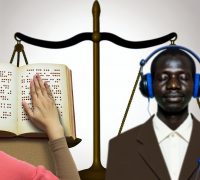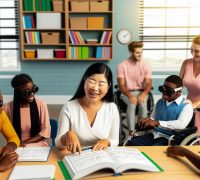Introduction
The Perkins Brailler stands out as a pivotal instrument for individuals who are blind or visually impaired, greatly enhancing their ability to write in Braille with efficiency. Mastering the use of this machine not only bolsters communication but also significantly promotes independence. This article delves into the basic operation and functionality of the Perkins Brailler, uncovering the nuances that make it a fundamental asset for Braille literacy.
Structure of the Perkins Brailler
Operating similarly to a traditional typewriter, the Perkins Brailler is distinctly designed for typing in Braille. Equipped with a layout that facilitates Braille writing, the machine features a set of six keys dedicated to dot formation, a centrally located spacebar, a mechanism for advancing lines, and a backspace key for correcting errors.
Braille Cell Configuration
A conventional Braille cell comprises six dots, strategically arranged in a matrix of two columns and three rows. Each dot within this structure is identified by a unique number ranging from 1 to 6. By pressing various combinations of these key-driven dots, users can create a wide array of characters and symbols essential for writing in Braille.
Basic Operation
Successfully typing in Braille using the Perkins Brailler demands a comprehensive understanding of the machine’s operational mechanics. The Brailler’s keys are distinctly numbered from 1 to 6, directly correlating with the dots comprising the Braille cell:
– Dot 1: Situated as the left-most key
– Dot 2: Located as the left inner key
– Dot 3: Identified as the left middle key
– Dot 4: Positioned as the right middle key
– Dot 5: Known as the right inner key
– Dot 6: Found as the right-most key
These keys are complemented by the centrally positioned spacebar, while the line spacer and backspace key are stationed towards the right and left of the keyboard, respectively.
Typing a Character
In order to type a character, one must simultaneously press the keys that correspond with the required Braille cell dots. For instance, to generate the letter k in Braille, keys numbered 1, 3, and 5 should be pressed concurrently.
Using the Spacebar
Creating space between words is achieved by a single press of the spacebar, mimicking the functionality found in traditional typewriters and modern computer keyboards.
Creating a New Line
To initiate a new line of text, the line spacer key is employed. This action advances the paper upwards and repositions the carriage at the commencement of the next line, ensuring seamless Braille writing across multiple lines.
Advanced Features
Beyond the rudimentary task of character entry, the Perkins Brailler houses advanced features that enrich its functionality for seasoned users.
Correcting Mistakes
When errors occur, the backspace key proves invaluable. By pressing this key, the user can retract one space to the left, providing an opportunity to overwrite the erroneous Braille with the correct dot configuration by pressing the appropriate combination of keys anew.
Paper Handling
The Perkins Brailler accommodates standard Braille paper, uniquely designed with a thicker texture to support the creation of raised dots. It is crucial to correctly insert and align the paper using the paper feed knobs and adjustable guide, ensuring optimal performance and precision in Braille text production.
Conclusion
Acquiring a thorough understanding of the Perkins Brailler’s functionalities unlocks a world of efficiency in Braille typing. This reliable machine not only aids in the production of Braille text but also serves as a vital tool in learning and communication for individuals who are blind or visually impaired. For those seeking to deepen their knowledge of Braille resources and tools, additional resources are available, fostering Braille literacy and technological proficiency.



